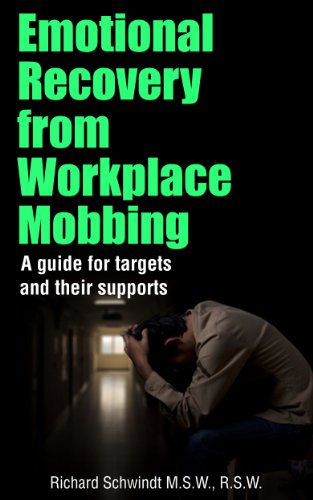Emotional Recovery from Workplace Mobbing
If you have a loved one experiencing workplace mobbing, or you are now experiencing mobbing, you will find hope and some helpful suggestions in the book Emotional Recovery from Workplace Mobbing.

Workplace mobbing and healing for homesteaders
Some people turn to homesteading because they can’t stand “politics.” By “politics” they mean the petty rivalries and painful personal attacks that happen every day at work. When these are extreme they are classed as bullying and workplace mobbing. I did a casual survey on my social media connections and found that 20 of my homesteading followers admitted to experiencing workplace mobbing — about 2 % who saw the post. Several of these mentioned that this was their motivation for homesteading and self-employment. Two people said that they were fired in the last week, due to workplace bullying — I cried when I read their pain. One of the people who responded affirmatively is a neighbour.
I’ve also been the victim of mobbing — although mine happened in a church — it is no less painful. This book is a helpful guide to pushing through the pain, defining what it is (it’s not your fault), and moving on — to healing and to a better work experience, whether through self-employment, homestead self-reliance, or a better work environment.
Book Review, Emotional Recovery from Workplace Mobbing, a guide for targets and their supports, by Richard Schwindt (2013)
4 stars out of 5
Emotional Recovery from Workplace Mobbing: A Guide for Targets and Their Supports
Who is Richard Schwindt?
Richard Schwindt is a therapist and social worker. He has firsthand experience as a survivor of workplace mobbing, and as a counsellor to people who are also survivors of workplace mobbing. He speaks with empathy and offers an overview of the types of therapy that may help other survivors heal from this all too common abuse.
What’s Emotional Recovery from Workplace Mobbing about?
The book begins with a first aid kit for those who are trapped in the situation of workplace mobbing, the most common form of workplace bullying. These are common sense suggestions that may be overlooked when you are under the stress of being mobbed — drink lots of water, get enough sleep, avoid substance abuse, which can make it more difficult to cope, eat properly, and exercise. These are the foundation to healing and the first things to go by the wayside when a person goes into double-drive – drawing on adrenaline — to try to please the mobsters.
Workplace mobbing is way more common than one would believe. “Mobbing more often takes place in environments with job security, unions, good pay and benefits. Mobbing can happen anywhere but Universities, Schools, Social (Service) and Volunteer Agencies, Hospitals and Civil Service offices are hotbeds.” (p. 11) Churches are also implicated. Victims are reticent to speak out about their abuse. There is shame. There is fear. Professions are close-knit groups where word gets around and victims are often harassed at the professional level, making it impossible to find future work in their field. In a smaller community, the word gets around, and victims’ lives are made more difficult and their future prospects are threatened by the bully.
What is mobbing?
“’Mobbing’, which University of Waterloo Sociology Professor Kenneth Westhues describes as the ‘stressor to beat all stressors ‘, is a viral phenomenon: ‘normally carried out politely, without any violence, and with ample written documentation. Yet even without the blood, the bloodlust is essentially the same: contagion and mimicking of unfriendly, hostile acts toward the target; relentless undermining of the target’s self-confidence; group solidarity against one whom all agree does not belong; and the euphoria of collective attack.’” (p. 13)
There are 5 stages common in all workplace mobbing:
-
“Avoidance and ostracization of the target.
-
Petty harassment: making the target’s life difficult.
-
A critical incident that triggers formal sanctions: “something has to be done”.
-
Aftermath of the incident: hearings, appeals, mediation.
-
Elimination: target quits, retires, is fired, becomes disabled, dies of stress related illness, or commits suicide.” (p. 13)
Mr. Schwindt suggests that survivors of the mobsters learn as much as they can about workplace mobbing. There is power in knowledge. Women are twice as likely to be mobbed at work as men are. One-third of the victims of workplace mobbing are men. Women are equally likely to be the abusers as men are. Mr. Schwindt is brave to speak out about mobbing. There is little in the literature to help the victim heal.
Rewrite your resume
This book offers some basic treatment suggestions – but it is not a DIY healing book. If you picked up this book thinking it would show you how to change your workplace into a place of love, esteem, and respect – you won’t find it here. Mr. Schwindt confesses,
“In most cases I think people should consider leaving their workplace. Some of my clients get lucky and something changes at work but generally it doesn’t. I do not believe that people can recover emotionally while remaining exposed to abuse. For people who remain in any abusive context we are more talking about survival. As a therapist I have to take a stand for people’s emotional health. I want you in a safe place where you are respected and honoured for who you are and can therefore heal.” (p. 26)
Part 1 in the book defines workplace mobbing and offers some basic suggestions for recognizing workplace mobbing and beginning healthy self-care. Part 2 in the book lists treatment protocols that are available, how each one works and what it might look like to help reframe the mobbing and move on as a stronger, more resilient human being.
Why I gave this book 4 stars out of 5
I gave this book 4 stars instead of five because it is written from the limited, disinterested, perception of a clinician. Although Mr. Schwindt has been a victim of mobbing himself, he speaks from the disassociated perspective of a clinician, not from fellow-feeling or like-heartedness. Although the book begins with the promise that you will come out of reading the book a stronger more resilient person, there are no stories of people, real or imagined, that experienced mobbing, quit their jobs, found healing, and are now back at work where they are loved, respected, and thriving. We don’t meet anyone who quit their abusive workplace to strike out in self-employment and is now making more money self-employed and thriving than they ever made from their secure, government job. Fortunately, there are people who do bear this story, so there is real hope. But Mr. Schwindt forgot to tell us these stories in his work. There are brief introductions to people (not real people) but their stories aren’t told, and we don’t see them healed, even imaginary healing would be helpful. All survivors want to sing with Johnny Paycheck, “Take this job and shove it,” without the damage to their professional careers that they fear would ensue if they sang out loud. Please give them hope, Mr. Schwindt.
Further, as a layperson, I resent the referral to all of the mobbing survivors as “the target.” This reference is how Mr. Schwindt refers to those who are in therapy and on their way to wholeness. The dichotomy of professional and patient seems out of place in this book, where Mr. Schwindt lists his credentials as being a victim of workplace mobbing, among other things. Targets are killed. In fact, the goal in most sports is to hit the target dead-on. Perhaps “survivor,” “patient,” “client,” “customer,” or “person who has experienced workplace mobbing” would be more empathetic and to the point. Each time I read the word “target” I had a subconscious reflex to duck.
Bonus this book has two invaluable qualities: A linked table of contents, and an annotated bibliography. These are vital and will save you time because I’m sure after you’ve skimmed through the book once you’ll want to go back and clarify some of the treatment modalities that you feel warrant another look in your circumstances. You may even want to read some of the books in the bibliography to gain a broader understanding and greater empowerment.
If you have a loved one experiencing workplace mobbing, or you are now experiencing mobbing, you will find hope and some helpful suggestions in this book. If you are a counsellor or a human resource manager you will broaden your understanding of this workplace pathology and be more valuable to your clients after reading this book. This book is a good introduction to the little talked about phenomenon – as old as the institutions where it is so prevalent. This book, however, won’t change the psychopaths that you have to work with every day.
Homesteads are healing. Digging in the garden, growing flowers, watching honey bees, and petting baby goats are all healing to the soul and should be an adjunct to everyone experiencing workplace mobbing. So after you read this book, plant some peas.
Disclaimer: I received a free copy of this eBook in exchange for my honest review. This post contains affiliate links. Photo credit: Used with permission from Jonathan Christian.




Leave a Reply